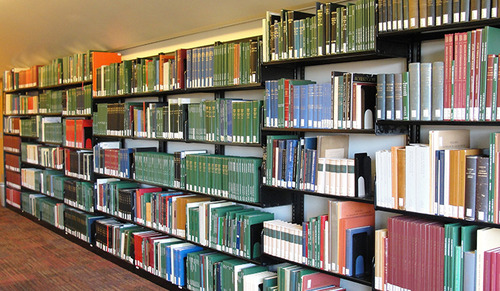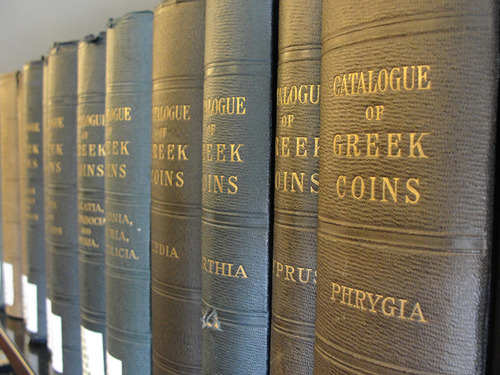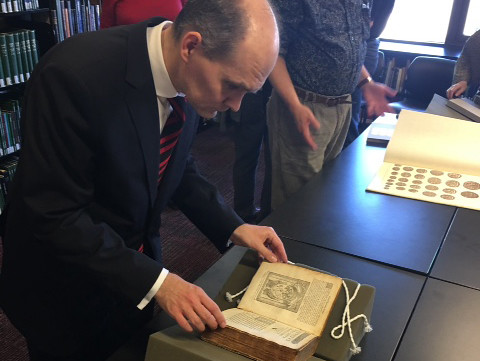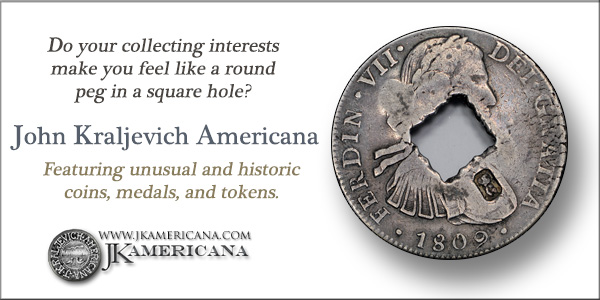
PREV ARTICLE
NEXT ARTICLE
FULL ISSUE
PREV FULL ISSUE
THE FRANK L. KOVACS NUMISMATIC LIBRARY
The June 2016 issue of the Stanford Libraries Newsletter has a great article about its recent acquisition of the Frank L. Kovacs Numismatic Library. Here's an excerpt - be sure to read the complete version online.
-Editor

The Frank L. Kovacs Numismatic Library, undoubtedly one of the largest and most complete reference collections on ancient numismatics situated on the West coast of the U.S., is now housed at the Stanford Libraries and was immediately put to use by students and a visiting professor throughout spring-quarter seminars. An important reference library and treasured Bay Area resource was at risk of being dismantled until six local numismatists offered to purchase the entire collection for Stanford in support of ongoing research on ancient economies and coinage. Comprising more than 2,700 catalog records and occupying 325 linear feet of shelving in the Raubitschek Room in Cecil H. Green Library, the collection has been named the Frank L. Kovacs Numismatic Library. This finally puts the Raubitschek Room in the position to provide coverage of all three major types of primary documentary evidence – coins, inscriptions, and papyri – for the ancient world,” said Walter Scheidel, the Dickason Professor in the Humanities.

According to Scheidel, who was Chair of Classics at the time of the acquisition, “Access to this collection is invaluable in establishing the study of ancient numismatics as a critical component of our Classics program.”
Right Place, Right Time “The Kovacs Library has dramatically broadened Stanford’s collections,” said University Librarian Michael Keller. “The overlap with the Libraries’ pre-existing holdings was less than 30 percent, making it a highly valued addition.” In merely months after the collection’s arrival, Dr. Bernhard Woytek, head of the division Documenta Antiqua, a research center for numismatics, epigraphy and papyrology at the Institute for the Study of Ancient Culture at the Austrian Academy of Sciences, took up an appointment as visiting associate professor of Classics and offered two numismatic courses. “In numismatics, as in all other disciplines dealing with documentary sources of the ancient world, like epigraphy and papyrology, it is essential to work hands-on with the primary material,” Dr. Woytek stated. Upon this premise were founded an undergraduate course, Describing and Identifying Ancient Coins, and a graduate proseminar, Ancient Numismatics. Students used volumes from the Kovacs Library alongside coins in Stanford’s collections. In May, members of the numismatic community, students, faculty, and library donors attended the opening of the Kovacs Library. Dr. Woytek kindly delivered the keynote lecture titled “Numismatics and the Mind of Man: The Study of Ancient Coins from the Renaissance to the 21st Century.

Dr. Woytek examining a 1567 edition of works by Guillaume Du Choul “Numismatics plays a vital role in broader studies of economics and many other interdisciplinary inquiries. We look forward to continuing to build the Kovacs Library for scholarly exploration,” said Keller, who before coming to Stanford in 1993 managed the numismatic collections at Yale Libraries as associate university librarian and director of collection development. Any expressions of support and encouragement from the numismatic community would be greatly appreciated. To discuss opportunities, please call the Library Development Office at 650-723-3866.
When I learned earlier this year from Mary Lannin about the donation of the Kovacs library to Stanford I understood it was important, but I had no idea how extensive it was. What a great home for such a marvelous resource!
Congratulations to the University, and thanks to the donors who made it possible. Thanks also to CoinsWeekly, where I first learned of this article. -Editor
To read the complete Stanford article, see:
To read the complete CoinsWeekly article, see:

Wayne Homren, Editor The Numismatic Bibliomania Society is a non-profit organization promoting numismatic literature. See our web site at coinbooks.org. To submit items for publication in The E-Sylum, write to the Editor at this address: whomren@gmail.com To subscribe go to: https://my.binhost.com/lists/listinfo/esylum All Rights Reserved. NBS Home Page Contact the NBS webmaster 
|